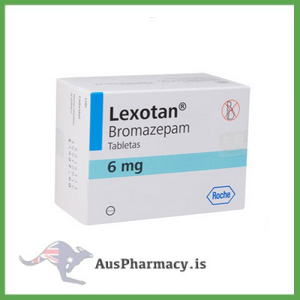Introduction
Lexotan (Bromazepam) is a benzodiazepine derivative studied extensively in pharmacology and neuroscience education.
Within the academic field, it serves as a key example to understand gamma-aminobutyric acid (GABA)-ergic neurotransmission, CNS depressant pharmacodynamics, and structure-activity relationships among benzodiazepines.
While Bromazepam is widely known for clinical use, in education, it functions as a model compound for exploring:
-
Receptor-binding theories
-
Anxiolytic pharmacology
-
Drug–neurotransmitter interactions
2. Educational Significance
Lexotan provides students and researchers with an illustrative example of how small molecular modifications influence drug–receptor affinity and CNS activity.
In classrooms and laboratories, it is frequently used to explain:
-
The benzodiazepine receptor complex
-
The GABA_A receptor mechanism
-
The principles of CNS pharmacology
Through its predictable pharmacokinetic behavior, Bromazepam helps learners explore drug metabolism, absorption, and elimination mechanisms.
3. Chemical Profile and Classification
| Parameter | Description |
|---|---|
| Generic Name | Bromazepam |
| Brand Name | Lexotan |
| Chemical Class | Benzodiazepine derivative |
| Molecular Formula | C₁₄H₁₀BrN₃O |
| Educational Focus | CNS depressant model compound |
| Mechanism Target | GABA_A receptor (benzodiazepine binding site) |
This structure helps teach students about halogen-substituted benzodiazepines and how halogen atoms like bromine alter lipophilicity and receptor affinity.
4. Mechanism of Action (Educational Explanation)
Lexotan acts by enhancing the effect of GABA, the primary inhibitory neurotransmitter in the brain.
It binds to a specific site on the GABA_A receptor complex, increasing the frequency of chloride ion channel opening.
In academic studies, this mechanism serves to demonstrate:
-
Ion channel regulation
-
Inhibitory neurotransmission
-
Drug–receptor synergy
By promoting hyperpolarization, Bromazepam reduces neuronal excitability — a critical concept in neuropharmacology training.
5. Pharmacodynamics and Educational Relevance
Bromazepam’s pharmacodynamic behavior offers a simplified teaching model for explaining:
-
Sedative-hypnotic activity
-
Dose–response relationships
-
Receptor sensitivity and downregulation
Educational models often highlight the receptor desensitization process, explaining why long-term benzodiazepine use affects GABA receptor expression.
6. Pharmacokinetics (ADME Framework)
| Process | Academic Explanation |
|---|---|
| Absorption | Rapid gastrointestinal absorption used to explain bioavailability studies |
| Distribution | High lipid solubility — demonstrates blood-brain barrier penetration |
| Metabolism | Hepatic oxidation — ideal for liver enzyme studies (CYP3A4 pathways) |
| Excretion | Renal elimination — applied in pharmacokinetic modeling |
| Half-life | Approx. 10–20 hours, used to teach elimination rate constants |
This makes Lexotan a useful molecule for ADME (Absorption, Distribution, Metabolism, Excretion) teaching frameworks.
7. Molecular and Structural Education
Bromazepam’s molecular structure provides insight into:
-
Ring fusion systems typical of benzodiazepines
-
Halogen substitution effects on receptor binding
-
Stereochemistry and pharmacological potency
Students learn how structural differences between compounds like Bromazepam, Diazepam, and Lorazepam influence potency and receptor selectivity.
8. Neurochemical Mechanisms
Educational modules using Lexotan often emphasize:
-
The balance between excitatory and inhibitory neurotransmission
-
The role of chloride ion channels in neuronal stability
-
The GABAergic pathway as a foundation of anxiety regulation mechanisms
Understanding these processes helps students link molecular pharmacology with neurobiological function.
9. Comparative Educational Context
Bromazepam is compared academically with:
-
Diazepam (longer half-life benzodiazepine)
-
Lorazepam (higher potency, shorter duration)
-
Clonazepam (anticonvulsant benzodiazepine)
This comparative approach deepens understanding of drug classification and pharmacological diversity within the benzodiazepine family.
10. Academic Applications
Lexotan is used in:
-
Pharmacology courses for receptor theory demonstration
-
Neuroscience classes studying neurotransmission control
-
Pharmacy training explaining drug metabolism pathways
-
Toxicology lessons focusing on CNS depressant mechanisms
Through simulated laboratory models, students observe how drugs alter synaptic activity and electrical signaling.
11. Laboratory Simulation
Many universities employ computer-based receptor binding simulations using the Lexotan molecular model.
This allows visualization of:
-
Ligand–receptor docking
-
Binding affinity variations
-
Conformational changes of receptor proteins
Such educational tools promote interactive learning about pharmacodynamics and receptor pharmacology.
12. Pharmacological Education Themes
Lexotan supports teaching in:
-
CNS neurochemistry
-
GABA receptor dynamics
-
Ion channel modulation
-
Synaptic inhibition theory
-
Receptor desensitization and tolerance
These topics form essential components of neuropsychopharmacology curricula worldwide.
13. Academic Research Relevance
Researchers and students use Bromazepam as a benchmark compound for:
-
GABA receptor modeling studies
-
Drug discovery simulations
-
Behavioral pharmacology education
-
Metabolic enzyme interaction experiments
It serves as a foundation for understanding how benzodiazepines influence behavioral neuroscience.
14. Ethical and Educational Context
Educational usage always emphasizes ethical considerations, such as:
-
Responsible study and laboratory safety
-
Avoiding misuse or non-academic application
-
Respecting the role of controlled substances in scientific education
These discussions strengthen understanding of drug policy, regulation, and responsible scientific handling.
15. Summary and Academic Conclusion
Lexotan (Bromazepam) plays a vital educational role in neuroscience and pharmacological sciences.
It bridges the gap between chemical theory and neurobehavioral mechanisms, making it a versatile model for academic exploration.
Key takeaways for students include:
-
Understanding GABAergic neurotransmission
-
Recognizing molecular determinants of receptor affinity
-
Applying pharmacokinetic and pharmacodynamic principles
-
Appreciating the structure-function relationship in neuroactive compounds
Through its molecular predictability, Lexotan remains an essential educational resource for studying central nervous system pharmacology.





